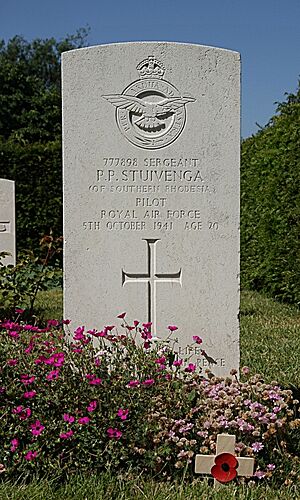No. 129 Squadron RAF facts for kids
Quick facts for kids No. 129 (Mysore) Squadron RAF |
|
|---|---|
| Country | |
| Branch | |
| Role | Fighter Command. |
| Nickname(s) | Mysore |
| Motto(s) | I will defend the right. |
| Aircraft | Supermarine Spitfire North American Mustang |
| Engagements | • World War II • Home Defence • Operation Overlord |
| Insignia | |
| Squadron Badge heraldry | The Gunda Bherunda of MysoreThe badge associates the sqn with the Indian Province of Mysore. |
No. 129 (Mysore) Squadron was a special unit of the Royal Air Force (RAF) that played an important role during World War II. This squadron was known for its brave pilots and powerful aircraft, helping to defend the United Kingdom and support Allied operations.
Contents
Early Days in World War I
No. 129 Squadron was first formed during the last few months of World War I. It was meant to be a unit for day bombing missions. The squadron was based at RAF Duxford. However, the war ended before the squadron could begin any operations.
No. 129 (Mysore) Squadron in World War II

The squadron was brought back to life on June 16, 1941, at RAF Leconfield. At this time, it was equipped with the famous Supermarine Spitfire aircraft.
A Special Name: Mysore
The Indian government helped the war effort by raising a lot of money. They did this by selling special War Bonds. To show thanks, several RAF squadrons were given names of Indian cities and regions. This is how No. 129 became No. 129 (Mysore) Squadron. It was named after the Mysore province in southwest India. The squadron's special badge, which shows the Ghunda Berunda of Mysore, also celebrates this connection.
Protecting the Skies
In August 1942, the squadron flew missions to protect bombers. They also carried out attacks over France. Soon after, the squadron moved to Orkney in northern Scotland. Their new job was to help defend the local area from air attacks.
Return to Action
In February 1943, the squadron moved back south. They began new missions, including attacking enemy ships and escorting other aircraft. In June 1943, 129 Squadron became part of the 2nd Tactical Air Force. This was a large air force unit designed to support ground troops.
New Aircraft for D-Day
In April 1944, the squadron switched to flying the P-51 Mustang. This powerful new aircraft was ready just in time for Operation Overlord. This was the code name for the D-Day landings in Normandy, France.
Fighting V-1 Flying Bombs
After D-Day, the squadron became part of the 133 (Polish) Wing. They then returned to RAF Brenzett. Here, their important job was to stop the German V-1 flying bombs. These were unmanned bombs that caused a lot of damage.
Long-Range Missions
In late 1944, the squadron moved to East Anglia. From there, they provided long-range fighter cover for RAF Bomber Command. This meant they protected bombers flying on daylight raids deep into enemy territory.
After the War
From June to December 1945, the squadron was stationed in Norway. During this time, they changed back to flying Spitfires. On September 1, 1946, at RAF Church Fenton, the squadron was renumbered. It became No. 257 Squadron.
Later, the squadron's legacy continued. It was turned into the 129 Tunbridge Wells squadron for air cadets. This group helps young people learn about aviation and the RAF.

